Videos by Ramón Álvarez-Vaz
En los estudios epidemiológicos en Salud Bucal que analizan los componentes del CPO (piezas denta... more En los estudios epidemiológicos en Salud Bucal que analizan los componentes del CPO (piezas dentales cariadas, per-
didas y obturadas), es habitual hacerlo en forma separada, lo que lleva a una pérdida de información relevante que está
contenida en la estructura multivariada de los datos. Por ese motivo resulta fundamental encontrar una forma de estudiar
los 3 componentes del CPO en conjunto. En el presente trabajo, se propone una alternativa gráfica que se denominará
CPO-grama, basado en el análisis de datos composicionales, que permitirá explorar las relaciones 2 a 2 de cada com-
ponente del CPO pero también su valor global, permitiendo visualizar en forma simultánea cada componente, el CPO y
otros atributos de cada persona estudiada. 2 views
Books by Ramón Álvarez-Vaz
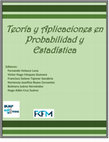
Teorı́a y Aplicaciones en Probabilidad y Estadı́stica, 2022
In this chapter, we present the general guidelines in the application
of two machine learning alg... more In this chapter, we present the general guidelines in the application
of two machine learning algorithms to detect a common cardiac arrhythmia, atrial
fibrillation (AF), when employing short-duration recordings taken through a porta-
ble single-lead electrocardiographic (ECG) electronic device. Due to the importance
of the early diagnosis of cardiovascular pathologies such as AF, our goal is to im-
prove the classification performance of the mobile device that, in practice, leaves
a relevant set of ECG recordings unclassified. We analyze the performance of su-
pervised classification techniques such as recursive partitioning and random forests
in combination with ECG signal feature extraction methods. Our methodology ap-
plies to an international ECG training set and a national test set of ECG recordings
generated in 2019 for the elder adult population of Uruguay, under a collaboration
between the CHSCV and the Ibirapitá Plan. The available diagnoses of the ECG
signals performed by expert clinical cardiologists allow the interpretation of the ob-
tained results.
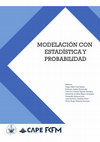
The purpose of this paper is to examine the principal characteristics of the students satisfaciti... more The purpose of this paper is to examine the principal characteristics of the students satisfacition construct, in higher education at Facultad de Ciencias Económicas y de Administración (FCEA), UdelaR (Uruguay), by Structural Equation Modelling.
The indicator proposed to measure students satisfaction considers cause-effect relationship between a set of variables considered as “background” and another set of variables considered as a “consequences” of satisfaction. In the first set we find
studentséxpectations, their image of the FCEA, the quality of teaching and services, and their perceived value, while within satisfaction “consequences” we find students’loyalty to the institution and the impact on the word-of-mouth.
The data used in this application come from a survey conducted on a random sample of students of the FCEA in 2009. The questionnaire applied, has 9 sets of questions; the first contains the variables that allow us to make a profile of the students according to their sociodemographic environment. On the other hand, the ECSI model variables (European
Customer Satisfaction Index) which will be used as inputs for the student’s satisfaction characterization.
The results, presented for a model with 22 observable variables and 7 unobservable constructs were obtained by Partial Least Squares estimation.
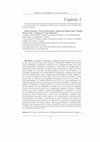
Estadística, Probabilidad y sus áreas de acción, 2021
In Spain, the Ministerio de Educación (Education Ministry) applies a test, at national level, kno... more In Spain, the Ministerio de Educación (Education Ministry) applies a test, at national level, known as the Evaluación General de Diagnóstico (EDG).
This test measures the schoolchildren academic performance in basic competen-
ces as linguistic communication, mathematics, knowledge and interaction with the
physical world, and social-civic competence. In this research, the information co-
llected in 2009 from 25295 fourth-year primary school students was used, with the
objective of proposing a reliable measure of general academic performance, which
collects the scores of the four aforementioned competencies and allows us tu es-
tablishing a schoolchildren classification, based on this measure. For this, a latent
class analysis was applied that was verified by means of a quadratic discriminant
analysis with 90 % coinciding cases and a CHAID analysis with 92.7 % coinciding
cases. The results show that a classification with three latent classes is sufficient to
explain the general academic performance. Thus, 32 % of schoolchildren in the sam-
ple were classified as having high academic performance, characterized by mainly
presenting high values in the 4 competencies, although schoolchildren with avera-
ge values in linguistic and mathematical communication were also detected; 51 %
with an average academic performance, characterized by having a medium level of
the four competences; and 17 % with low academic performance, characterized by
presenting low values in three competencies and average records in mathematics.
Finally, it is detected that the highest proportion of schoolchildren in private schools
report a high level of achievement, while the highest proportion of schoolchildren in
public schools report an average academic performance. Furthermore, the highest
proportion of schoolchildren who do not repeat have a high academic performance,
while the highest proportion of schoolchildren who repeat report a low academic
performance.
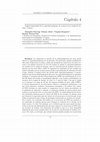
Estadística, Probabilidad y sus áreas de acción, 2021
Exposure to the rice industrialization environment can affect the lung
capacity of individuals. I... more Exposure to the rice industrialization environment can affect the lung
capacity of individuals. In particular, respiratory disorders may occur in children
who spend several hours in areas close to rice mills. This work analyzes the lung
capacity of schoolchildren in the city of Artigas, an area of concentration of rice mills,
between 2015 and 2016. The results of this study are compared with values obtained
in previous work [3] for a reference population of the country. In addition, the link
between lung capacity and proximity to the rice industrialization environment is
investigated. Healthcare professionals measure lung capacity by Peak Expiratory
Flow (PEF). The study design is longitudinal applied to a probabilistic sample
of schoolchildren from the city of Artigas, aged 4 to 7 years, who were measured
on 4 occasions over a year. Weight, height and PEF measurements were taken,
and information on the clinical history and environmental conditions, to which the
children are exposed, was obtained through questionnaires given to the parents. The
PEF values collected on each occasion were compared with the percentile values
of the reference population and, in addition, mixed-effects models were fitted to
analyze the association between the trajectory of PEF and rice industrialization.
The results show that PEF values are below the expected, according to the reference
values for the country, indicating a potential higher risk of respiratory pathologies
in schoolchildren from Artigas. On the other hand, the results of the analysis of
the PEF trajectory are similar to those reported in previous studies for Uruguay in
terms of their relationship with age, weight and height. However, there is no evidence
that a higher degree of exposure to the rice industrialization environment worsens
the PFE trajectory among schoolchildren in Artigas. A limitation of the analysis is
that no information is available for other cities outside the rice mill concentration
zone. Therefore, it is relevant that future work analyze the PEF trajectories of
schoolchildren from different cities in order to have greater variability in exposure
to environmental contamination.
colección Biblioteca Plural, 2017
Los libros publicados en la presente colección han sido evaluados por académicos de reconocida tr... more Los libros publicados en la presente colección han sido evaluados por académicos de reconocida trayectoria, en las temáticas respectivas.
Colección Interdisciplinarias , 2012
Castellano) por su colaboración en las coordinaciones con los estudiantes y su apoyo en la tarea ... more Castellano) por su colaboración en las coordinaciones con los estudiantes y su apoyo en la tarea de campo. Al personal de la Escuela 317 Islas Baleares (maestra directora Ángela Fernández, maestras comunitarias Myriam Caraballo y Margarita Varela, maestras especializadas, maestras de apoyo y resto del personal docente, de apoyo administrativo y de servicios) y equipo técnico interdisciplinario, por el constante apoyo para que se pudieran realizar las actividades de toma de datos y talleres con padres y escolares. Al Programa Integral Metropolitano (PIM) a través de sus integrantes
Publicación de los resultados de la investigación financiada por CSIC a través de su programa I +... more Publicación de los resultados de la investigación financiada por CSIC a través de su programa I + D en los llamados correspondientes a los bienios:

colección Biblioteca Plural, 2017
El trabajo se divide en cuatro capı́tulos autocontenidos. En el primero se presenta el
trabajo de... more El trabajo se divide en cuatro capı́tulos autocontenidos. En el primero se presenta el
trabajo de Moreno titulado “Clustering robusto basado en modelos”. En este documento
el autor analiza y compara distintas técnicas de clustering basadas en modelos proba-
bilı́sticos con el objetivo de encontrar el procedimiento más eficiente y estable entre el
conjunto analizado, considerando diferentes tipologı́as de datos, en presencia de outliers.
Se prueba este enfoque en la conformación de grupos para un conjunto de inmuebles de
Montevideo y Canelones a partir del precio de ellos, los metros cuadrados construidos y
del terreno en el que se aloja el inmueble.
En el siguiente capı́tulo, se presenta el trabajo de Coimbra y Antı́a titulado “Trata-
miento de la no respuesta en encuestas de panel en el caso de poblaciones finitas”, cuyo
objetivo es abordar una forma de tratamiento de la no respuesta en un tipo especı́fico de
encuestas por muestreo, las encuestas de panel.
En el capı́tulo tres, en una lı́nea próxima al trabajo de Moreno, se presenta el trabajo
de Massa cuyo tı́tulo es “Efecto de valores faltantes en estudios longitudinales en adultos
mayores”. Es ente trabajo se aborda la forma de solucionar el problema del abandono de
los sujetos incluidos en estudios denominados Mini Mental State Examination (MMSE),
se centra en el uso de modelos conjuntos donde el tiempo de sobrevida de los sujetos y
los resultados del MMSE están relacionados.
Finalmente, en el último capı́tulo, se presenta el trabajo de Vernazza en el que se
analizan las propiedades psicométricas de un instrumento de medición de la satisfacción
estudiantil en nuestra Facultad de Ciencias Económicas y de Administración.
Papers by Ramón Álvarez-Vaz
Documentos de Trabajo del Instituto de Estadística (IESTA)

International Journal of Developmental and Educational Psychology
En este trabajo se analizan factores que se asocian con el rendimiento académico de escolares de ... more En este trabajo se analizan factores que se asocian con el rendimiento académico de escolares de cuarto de Educación Primaria, considerando variables propias del escolar, de su entorno escolar y de su contexto familiar. Los participantes analizados corresponden a 25245 escolares de cuarto nivel de Educación Primaria, evaluados por la "Evaluación General de Diagnóstico" en España en el año 2009. La estrategia estadística de análisis fue Análisis de Correspondencias Múltiples. Los principales resultados obtenidos permiten concluir que existe una asociación entre el alto rendimiento y la no repetición escolar, el gusto (bastante) por asistir a la escuela, la lengua en la que los escolares realizaron la prueba (evaluación en castellano) y titularidad de la escuela (privada). El alto rendimiento académico se asocia además con un alto nivel educativo de padres y madres. En cuanto a factores con los que se asocia un rendimiento académico considerado medio, se tiene el gusto por asistir a la escuela (mucho gusto), la lengua en la que realizaron las evaluaciones (valenciano y catalán), la titularidad de la escuela (públicas) y el nivel educativo del núcleo familiar (ESO/EGB). Por último, los factores asociados a valores bajos de rendimiento académico se identifican con poco gusto por asistir a la escuela (nada), repetición de al menos un año de primaria, realización de las pruebas en vasco y hogares monoparentales. No se detectan asociaciones entre el rendimiento académico y el sexo del escolar.
Odontoestomatolog{\\'\\i}a
Documentos de Trabajo del Instituto de Estad{\\'\\i}stica (IESTA)

Actas Odontol{\\'o}gicas
ABSTRACT. Teeth, essential components of stomatognathic system, stand as a splendid raw material ... more ABSTRACT. Teeth, essential components of stomatognathic system, stand as a splendid raw material for paleontological, archaeological, anthropological, genetic and forensic researches by virtue of their colossal resistance to extreme intra-vitam and/or post-mortem conditions. Information on their size has allowed the application of procedures for age estimation and sex determination, thus contributing to the process of human identification itself. Objectives: the aim of this paper was to verify whether mandibular and maxillary canine indexes were reliable and valid instruments for sex determination in a Uruguayan sample. Methods: the survey was an odontometric analysis of 1000 dental stone casts (475 upper – 238 from females and 237 from males -, and 525 inferior – 261 and 264 - respectively) belonging to patients, aged between 18 and 60 years, assisted in one orthodontic clinic of Montevideo, Uruguay, consisting of measurements of mesiodistal diameter of canines and intercanine distance, and calculation of canine indexes. Results: the overall success rate was 45.9% for the mandibular canine index and 50.52% for the maxillary canine index. Conclusions: mandibular and maxillary canine indexes did not allow safe sex determination in the questioned sample.

Actas Odontol{\\'o}gicas
ABSTRACT. This study is descriptive transversal type. The population observed was 542 children se... more ABSTRACT. This study is descriptive transversal type. The population observed was 542 children selected among Montevideo and Rivera Uruguayan provinces. Both sexes, public and private schools students, integrating preschoolers, and first degree were observed. The goal was to quantify the prescuted malocclusions in this group, its prevalence and to determine if it is a Public health issue. The age range used to quantify the malocclusions was this to determine if it is a public issue in Public health. In this task, a form was designed to consider the OMS parameters, written and restructured. Operators were calibrated for this job, which was done in 8hs in each institution. This analysis was compared in Rivera 1999 to the one done in the capital city in 2001, considering this age range. The result was the prevalence of the malocclusions in this age range in 70,7%, what reflects a high index of malocclusions. The relevant findings were oral health habits like atipic deglution, oral breath, as well as frenum (upper and lingual).
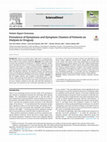
VALUE IN HEALTH REGIONAL ISSUES, 2019
Background: Patients on dialysis report high levels of symptom burden. The association of these s... more Background: Patients on dialysis report high levels of symptom burden. The association of these symptoms may have an increased dele-terious effect on the patients well-being. Objective: This study aimed to assess the prevalence of symptoms, to identify symptom clusters, and to describe the impact of concurrent symptoms on physical and emotional well-being in a sample of dialysis patients. Methods: Data of the first assessment of a longitudinal study aimed to assess patient-reported outcomes in dialysis were included here. The KDQOL-36 PCS, MCS and Symptom Subscale, the Hospital Anxiety and Depression Scales and the Epworth Sleepiness Scale were analyzed. The ICLUST procedure was followed for hierarchical cluster analyses. Results: Of the 512 eligible patients, 493 accepted to participate, 43.6 % were female, with mean age of 60.9 (SD=16.7). Treatment modality was HD in 87.6% of patients. Most prevalent and severe symptoms were muscle sores, cramps, washed out, dry skin, and itchy skin, Moderate to severe pain was reported by 25%, and daily somnolence by 12.4% of the patients. Five first level symptom clusters were identified as cuta-neous, cardiac, digestive, sensory-motor, energy. Both, the presence of any cluster and cluster scores were significantly associated with lower physical and mental quality of life and a higher psychological distress. Conclusions: Our study confirms the presence of high symptom burden in dialysis patients in Uruguay. Several symptom clusters were identified having significant impact on the patients well-being. The identification of symptom clusters can help to understand common underlying pathways. It is possible that the management of symptom clusters may reduce symptom burden in these patients.
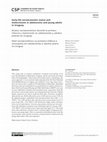
Cadernos de Saude Publica, 2018
This study aims to estimate orthodontic treatment need among 15-24
year-old individuals in Montev... more This study aims to estimate orthodontic treatment need among 15-24
year-old individuals in Montevideo, Uruguay, and the association of occlusal
traits with demographic, clinical and socioeconomic factors, considering a life
course approach. A cross-sectional study using data from the First National
Oral Health Survey in Uruguay was conducted. A two-stage cluster proce-
dure was used to select a sample of 278 individuals in Montevideo. Household
interviews and oral examinations were performed by six dentists. Dental Aes-
thetic (DAI) and Decayed Missing and Filled Teeth Indices (DMFT) were used
to assess orthodontic treatment need and dental caries, respectively. Early life
and current socioeconomic factors were obtained from the interview. Ordinal
logistic regression was used to model the DAI index. Prevalence of definite
malocclusion was 20.6%, followed by severe (8.2%) and very severe (7.6%). In
the adjusted analysis, individuals with untreated dental caries (OR = 1.11;
95%CI: 1.03-1.20) and those who reported a lower socioeconomic level at 6
years of age (OR = 5.52; 95%CI: 1.06-28.62) had a higher chance of being a
worse case of malocclusion. Current socioeconomic position was not associ-
ated with orthodontic treatment need. Individuals aged 22-24 years (OR =
1.59; 95%CI: 1.05-2.41) had a lower chance than those aged 14-17. This study
shows that orthodontic treatment need is relatively high in Uruguayan ado-
lescents and young adults. There is a potential relationship between early life
socioeconomic status and the occurrence of malocclusion in adolescents and
young adults under a life course approach.








Uploads
Videos by Ramón Álvarez-Vaz
didas y obturadas), es habitual hacerlo en forma separada, lo que lleva a una pérdida de información relevante que está
contenida en la estructura multivariada de los datos. Por ese motivo resulta fundamental encontrar una forma de estudiar
los 3 componentes del CPO en conjunto. En el presente trabajo, se propone una alternativa gráfica que se denominará
CPO-grama, basado en el análisis de datos composicionales, que permitirá explorar las relaciones 2 a 2 de cada com-
ponente del CPO pero también su valor global, permitiendo visualizar en forma simultánea cada componente, el CPO y
otros atributos de cada persona estudiada.
Books by Ramón Álvarez-Vaz
of two machine learning algorithms to detect a common cardiac arrhythmia, atrial
fibrillation (AF), when employing short-duration recordings taken through a porta-
ble single-lead electrocardiographic (ECG) electronic device. Due to the importance
of the early diagnosis of cardiovascular pathologies such as AF, our goal is to im-
prove the classification performance of the mobile device that, in practice, leaves
a relevant set of ECG recordings unclassified. We analyze the performance of su-
pervised classification techniques such as recursive partitioning and random forests
in combination with ECG signal feature extraction methods. Our methodology ap-
plies to an international ECG training set and a national test set of ECG recordings
generated in 2019 for the elder adult population of Uruguay, under a collaboration
between the CHSCV and the Ibirapitá Plan. The available diagnoses of the ECG
signals performed by expert clinical cardiologists allow the interpretation of the ob-
tained results.
The indicator proposed to measure students satisfaction considers cause-effect relationship between a set of variables considered as “background” and another set of variables considered as a “consequences” of satisfaction. In the first set we find
studentséxpectations, their image of the FCEA, the quality of teaching and services, and their perceived value, while within satisfaction “consequences” we find students’loyalty to the institution and the impact on the word-of-mouth.
The data used in this application come from a survey conducted on a random sample of students of the FCEA in 2009. The questionnaire applied, has 9 sets of questions; the first contains the variables that allow us to make a profile of the students according to their sociodemographic environment. On the other hand, the ECSI model variables (European
Customer Satisfaction Index) which will be used as inputs for the student’s satisfaction characterization.
The results, presented for a model with 22 observable variables and 7 unobservable constructs were obtained by Partial Least Squares estimation.
This test measures the schoolchildren academic performance in basic competen-
ces as linguistic communication, mathematics, knowledge and interaction with the
physical world, and social-civic competence. In this research, the information co-
llected in 2009 from 25295 fourth-year primary school students was used, with the
objective of proposing a reliable measure of general academic performance, which
collects the scores of the four aforementioned competencies and allows us tu es-
tablishing a schoolchildren classification, based on this measure. For this, a latent
class analysis was applied that was verified by means of a quadratic discriminant
analysis with 90 % coinciding cases and a CHAID analysis with 92.7 % coinciding
cases. The results show that a classification with three latent classes is sufficient to
explain the general academic performance. Thus, 32 % of schoolchildren in the sam-
ple were classified as having high academic performance, characterized by mainly
presenting high values in the 4 competencies, although schoolchildren with avera-
ge values in linguistic and mathematical communication were also detected; 51 %
with an average academic performance, characterized by having a medium level of
the four competences; and 17 % with low academic performance, characterized by
presenting low values in three competencies and average records in mathematics.
Finally, it is detected that the highest proportion of schoolchildren in private schools
report a high level of achievement, while the highest proportion of schoolchildren in
public schools report an average academic performance. Furthermore, the highest
proportion of schoolchildren who do not repeat have a high academic performance,
while the highest proportion of schoolchildren who repeat report a low academic
performance.
capacity of individuals. In particular, respiratory disorders may occur in children
who spend several hours in areas close to rice mills. This work analyzes the lung
capacity of schoolchildren in the city of Artigas, an area of concentration of rice mills,
between 2015 and 2016. The results of this study are compared with values obtained
in previous work [3] for a reference population of the country. In addition, the link
between lung capacity and proximity to the rice industrialization environment is
investigated. Healthcare professionals measure lung capacity by Peak Expiratory
Flow (PEF). The study design is longitudinal applied to a probabilistic sample
of schoolchildren from the city of Artigas, aged 4 to 7 years, who were measured
on 4 occasions over a year. Weight, height and PEF measurements were taken,
and information on the clinical history and environmental conditions, to which the
children are exposed, was obtained through questionnaires given to the parents. The
PEF values collected on each occasion were compared with the percentile values
of the reference population and, in addition, mixed-effects models were fitted to
analyze the association between the trajectory of PEF and rice industrialization.
The results show that PEF values are below the expected, according to the reference
values for the country, indicating a potential higher risk of respiratory pathologies
in schoolchildren from Artigas. On the other hand, the results of the analysis of
the PEF trajectory are similar to those reported in previous studies for Uruguay in
terms of their relationship with age, weight and height. However, there is no evidence
that a higher degree of exposure to the rice industrialization environment worsens
the PFE trajectory among schoolchildren in Artigas. A limitation of the analysis is
that no information is available for other cities outside the rice mill concentration
zone. Therefore, it is relevant that future work analyze the PEF trajectories of
schoolchildren from different cities in order to have greater variability in exposure
to environmental contamination.
trabajo de Moreno titulado “Clustering robusto basado en modelos”. En este documento
el autor analiza y compara distintas técnicas de clustering basadas en modelos proba-
bilı́sticos con el objetivo de encontrar el procedimiento más eficiente y estable entre el
conjunto analizado, considerando diferentes tipologı́as de datos, en presencia de outliers.
Se prueba este enfoque en la conformación de grupos para un conjunto de inmuebles de
Montevideo y Canelones a partir del precio de ellos, los metros cuadrados construidos y
del terreno en el que se aloja el inmueble.
En el siguiente capı́tulo, se presenta el trabajo de Coimbra y Antı́a titulado “Trata-
miento de la no respuesta en encuestas de panel en el caso de poblaciones finitas”, cuyo
objetivo es abordar una forma de tratamiento de la no respuesta en un tipo especı́fico de
encuestas por muestreo, las encuestas de panel.
En el capı́tulo tres, en una lı́nea próxima al trabajo de Moreno, se presenta el trabajo
de Massa cuyo tı́tulo es “Efecto de valores faltantes en estudios longitudinales en adultos
mayores”. Es ente trabajo se aborda la forma de solucionar el problema del abandono de
los sujetos incluidos en estudios denominados Mini Mental State Examination (MMSE),
se centra en el uso de modelos conjuntos donde el tiempo de sobrevida de los sujetos y
los resultados del MMSE están relacionados.
Finalmente, en el último capı́tulo, se presenta el trabajo de Vernazza en el que se
analizan las propiedades psicométricas de un instrumento de medición de la satisfacción
estudiantil en nuestra Facultad de Ciencias Económicas y de Administración.
Papers by Ramón Álvarez-Vaz
year-old individuals in Montevideo, Uruguay, and the association of occlusal
traits with demographic, clinical and socioeconomic factors, considering a life
course approach. A cross-sectional study using data from the First National
Oral Health Survey in Uruguay was conducted. A two-stage cluster proce-
dure was used to select a sample of 278 individuals in Montevideo. Household
interviews and oral examinations were performed by six dentists. Dental Aes-
thetic (DAI) and Decayed Missing and Filled Teeth Indices (DMFT) were used
to assess orthodontic treatment need and dental caries, respectively. Early life
and current socioeconomic factors were obtained from the interview. Ordinal
logistic regression was used to model the DAI index. Prevalence of definite
malocclusion was 20.6%, followed by severe (8.2%) and very severe (7.6%). In
the adjusted analysis, individuals with untreated dental caries (OR = 1.11;
95%CI: 1.03-1.20) and those who reported a lower socioeconomic level at 6
years of age (OR = 5.52; 95%CI: 1.06-28.62) had a higher chance of being a
worse case of malocclusion. Current socioeconomic position was not associ-
ated with orthodontic treatment need. Individuals aged 22-24 years (OR =
1.59; 95%CI: 1.05-2.41) had a lower chance than those aged 14-17. This study
shows that orthodontic treatment need is relatively high in Uruguayan ado-
lescents and young adults. There is a potential relationship between early life
socioeconomic status and the occurrence of malocclusion in adolescents and
young adults under a life course approach.
didas y obturadas), es habitual hacerlo en forma separada, lo que lleva a una pérdida de información relevante que está
contenida en la estructura multivariada de los datos. Por ese motivo resulta fundamental encontrar una forma de estudiar
los 3 componentes del CPO en conjunto. En el presente trabajo, se propone una alternativa gráfica que se denominará
CPO-grama, basado en el análisis de datos composicionales, que permitirá explorar las relaciones 2 a 2 de cada com-
ponente del CPO pero también su valor global, permitiendo visualizar en forma simultánea cada componente, el CPO y
otros atributos de cada persona estudiada.
of two machine learning algorithms to detect a common cardiac arrhythmia, atrial
fibrillation (AF), when employing short-duration recordings taken through a porta-
ble single-lead electrocardiographic (ECG) electronic device. Due to the importance
of the early diagnosis of cardiovascular pathologies such as AF, our goal is to im-
prove the classification performance of the mobile device that, in practice, leaves
a relevant set of ECG recordings unclassified. We analyze the performance of su-
pervised classification techniques such as recursive partitioning and random forests
in combination with ECG signal feature extraction methods. Our methodology ap-
plies to an international ECG training set and a national test set of ECG recordings
generated in 2019 for the elder adult population of Uruguay, under a collaboration
between the CHSCV and the Ibirapitá Plan. The available diagnoses of the ECG
signals performed by expert clinical cardiologists allow the interpretation of the ob-
tained results.
The indicator proposed to measure students satisfaction considers cause-effect relationship between a set of variables considered as “background” and another set of variables considered as a “consequences” of satisfaction. In the first set we find
studentséxpectations, their image of the FCEA, the quality of teaching and services, and their perceived value, while within satisfaction “consequences” we find students’loyalty to the institution and the impact on the word-of-mouth.
The data used in this application come from a survey conducted on a random sample of students of the FCEA in 2009. The questionnaire applied, has 9 sets of questions; the first contains the variables that allow us to make a profile of the students according to their sociodemographic environment. On the other hand, the ECSI model variables (European
Customer Satisfaction Index) which will be used as inputs for the student’s satisfaction characterization.
The results, presented for a model with 22 observable variables and 7 unobservable constructs were obtained by Partial Least Squares estimation.
This test measures the schoolchildren academic performance in basic competen-
ces as linguistic communication, mathematics, knowledge and interaction with the
physical world, and social-civic competence. In this research, the information co-
llected in 2009 from 25295 fourth-year primary school students was used, with the
objective of proposing a reliable measure of general academic performance, which
collects the scores of the four aforementioned competencies and allows us tu es-
tablishing a schoolchildren classification, based on this measure. For this, a latent
class analysis was applied that was verified by means of a quadratic discriminant
analysis with 90 % coinciding cases and a CHAID analysis with 92.7 % coinciding
cases. The results show that a classification with three latent classes is sufficient to
explain the general academic performance. Thus, 32 % of schoolchildren in the sam-
ple were classified as having high academic performance, characterized by mainly
presenting high values in the 4 competencies, although schoolchildren with avera-
ge values in linguistic and mathematical communication were also detected; 51 %
with an average academic performance, characterized by having a medium level of
the four competences; and 17 % with low academic performance, characterized by
presenting low values in three competencies and average records in mathematics.
Finally, it is detected that the highest proportion of schoolchildren in private schools
report a high level of achievement, while the highest proportion of schoolchildren in
public schools report an average academic performance. Furthermore, the highest
proportion of schoolchildren who do not repeat have a high academic performance,
while the highest proportion of schoolchildren who repeat report a low academic
performance.
capacity of individuals. In particular, respiratory disorders may occur in children
who spend several hours in areas close to rice mills. This work analyzes the lung
capacity of schoolchildren in the city of Artigas, an area of concentration of rice mills,
between 2015 and 2016. The results of this study are compared with values obtained
in previous work [3] for a reference population of the country. In addition, the link
between lung capacity and proximity to the rice industrialization environment is
investigated. Healthcare professionals measure lung capacity by Peak Expiratory
Flow (PEF). The study design is longitudinal applied to a probabilistic sample
of schoolchildren from the city of Artigas, aged 4 to 7 years, who were measured
on 4 occasions over a year. Weight, height and PEF measurements were taken,
and information on the clinical history and environmental conditions, to which the
children are exposed, was obtained through questionnaires given to the parents. The
PEF values collected on each occasion were compared with the percentile values
of the reference population and, in addition, mixed-effects models were fitted to
analyze the association between the trajectory of PEF and rice industrialization.
The results show that PEF values are below the expected, according to the reference
values for the country, indicating a potential higher risk of respiratory pathologies
in schoolchildren from Artigas. On the other hand, the results of the analysis of
the PEF trajectory are similar to those reported in previous studies for Uruguay in
terms of their relationship with age, weight and height. However, there is no evidence
that a higher degree of exposure to the rice industrialization environment worsens
the PFE trajectory among schoolchildren in Artigas. A limitation of the analysis is
that no information is available for other cities outside the rice mill concentration
zone. Therefore, it is relevant that future work analyze the PEF trajectories of
schoolchildren from different cities in order to have greater variability in exposure
to environmental contamination.
trabajo de Moreno titulado “Clustering robusto basado en modelos”. En este documento
el autor analiza y compara distintas técnicas de clustering basadas en modelos proba-
bilı́sticos con el objetivo de encontrar el procedimiento más eficiente y estable entre el
conjunto analizado, considerando diferentes tipologı́as de datos, en presencia de outliers.
Se prueba este enfoque en la conformación de grupos para un conjunto de inmuebles de
Montevideo y Canelones a partir del precio de ellos, los metros cuadrados construidos y
del terreno en el que se aloja el inmueble.
En el siguiente capı́tulo, se presenta el trabajo de Coimbra y Antı́a titulado “Trata-
miento de la no respuesta en encuestas de panel en el caso de poblaciones finitas”, cuyo
objetivo es abordar una forma de tratamiento de la no respuesta en un tipo especı́fico de
encuestas por muestreo, las encuestas de panel.
En el capı́tulo tres, en una lı́nea próxima al trabajo de Moreno, se presenta el trabajo
de Massa cuyo tı́tulo es “Efecto de valores faltantes en estudios longitudinales en adultos
mayores”. Es ente trabajo se aborda la forma de solucionar el problema del abandono de
los sujetos incluidos en estudios denominados Mini Mental State Examination (MMSE),
se centra en el uso de modelos conjuntos donde el tiempo de sobrevida de los sujetos y
los resultados del MMSE están relacionados.
Finalmente, en el último capı́tulo, se presenta el trabajo de Vernazza en el que se
analizan las propiedades psicométricas de un instrumento de medición de la satisfacción
estudiantil en nuestra Facultad de Ciencias Económicas y de Administración.
year-old individuals in Montevideo, Uruguay, and the association of occlusal
traits with demographic, clinical and socioeconomic factors, considering a life
course approach. A cross-sectional study using data from the First National
Oral Health Survey in Uruguay was conducted. A two-stage cluster proce-
dure was used to select a sample of 278 individuals in Montevideo. Household
interviews and oral examinations were performed by six dentists. Dental Aes-
thetic (DAI) and Decayed Missing and Filled Teeth Indices (DMFT) were used
to assess orthodontic treatment need and dental caries, respectively. Early life
and current socioeconomic factors were obtained from the interview. Ordinal
logistic regression was used to model the DAI index. Prevalence of definite
malocclusion was 20.6%, followed by severe (8.2%) and very severe (7.6%). In
the adjusted analysis, individuals with untreated dental caries (OR = 1.11;
95%CI: 1.03-1.20) and those who reported a lower socioeconomic level at 6
years of age (OR = 5.52; 95%CI: 1.06-28.62) had a higher chance of being a
worse case of malocclusion. Current socioeconomic position was not associ-
ated with orthodontic treatment need. Individuals aged 22-24 years (OR =
1.59; 95%CI: 1.05-2.41) had a lower chance than those aged 14-17. This study
shows that orthodontic treatment need is relatively high in Uruguayan ado-
lescents and young adults. There is a potential relationship between early life
socioeconomic status and the occurrence of malocclusion in adolescents and
young adults under a life course approach.
in the undergraduate courses of the Faculty of Economics and Administration, through the
cluster analysis. The application was made on data obtained by applying a questionnaire
on a sample of students in 2009. The questionnaire results from an adaptation of an nstrument created by the researchers Alves and Raposo (Alves and Raposo, 2004) and presents the following structure: the first
block contains sociodemographic variables and variables that characterize the student within the scope of the faculty. The remaining
eight blocks of questions (ECSI model) all have the same structure: a general question that determines the essence of the block and
from it arises, a series of statements on which the student must express their position is established using a Likert scale which takes
values in the range [1 to 10], where 1 indicates the greatest discrepancy with the point in question, and 10 the greatest agreement.
Regarding the main results obtained from the realization of a clusterization/grouping based on a hierarchical method (in particular,
the Ward method), the first thing that is evaluated is the number of clusters to be determined. Considering the dendrogram and some
test indicators, it means appropriate to consider the existence of 3 groups of students. The distribution of students by the clusters is
36 %, 43 %, 31 %, in cluster 1, 2 and 3, respectively.
determining an important contribution of foreign currency each season
(April to October of each year).
Therefore, it is considered relevant to characterize the economic
variables involved in this activity, particularly expenditure.
Using data from Ministerio de Turismo (Ministry of Tourism) of cruise
ships of the 2010-2011 season, this work compares the typology that
emerged applying hierarchical and non-hierarchical clustering
methods, with those emerged when applying the network analysis
(SNA) to the expenditure data in cruise passengers.
Previously the authors had built a typology of cruise passengers,
resulting from applying Ward's algorithm distances for binary variables
(spend or not spend) in five items of expenditure.
Cruise data is obtained from a sample of passengers at through a face-
to-face survey with complex sample design.
Information on people and spending is available since the 2005-2006
season; the present work focuses on the 2010-2011 season.
On the binary expenses in each cruise, graphs are constructed, to
which several metrics are applied for its description.
Using the previous typology of expenditures, the authors study the
association between socio-demographic characteristics of the cruise
passengers with the groups created previously and the communities
identified with the SNA, to determine patterns of behavior considering
the expense when changing the type of cruise.
En este trabajo se presentan los principales resultados obtenidos al
realizar un estudio de la caracterización de la Satisfacción Estudiantil,
en los cursos de grado de la Facultad de Ciencias Económicas y de
Administración, Universidad de la República, Uruguay, a través de la
utilización y comparación de dos técnicas de análisis de datos
multivariantes: Análisis de Clases Latentes y Análisis de Clusters. Los
datos utilizados provienen de una encuesta aplicada sobre una
muestra de estudiantes de la Facultad. El cuestionario presenta una
estructura de 2 bloques. El primero, presenta las variables que
permitirán realizar una caracterización sociodemográfica de los
estudiantes, y el segundo contiene 63 ítems subdivididos en 8 escalas
asociadas al modelo ECSI que serán las utilizadas para la
caracterización de la Satisfacción Estudiantil. Las variables manifiestas
consideradas para la construcción y caracterización de la Satisfacción
Estudiantil son las siguientes: expectativas de los estudiantes al
ingresar al centro de estudios, la imagen que tienen de éste, la calidad
de la enseñanza recibida y de los servicios brindados, las necesidades y
deseos personales con respecto a la Facultad y el valor percibido. Estas
variables surgen de agrupar los ítems del ECSI, por escala. Los
resultados presentados surgen, de considerar que efectivamente existe
una variable que refiere a la Satisfacción Estudiantil y que ésta queda
definida, a partir de la interacción de las 6 variables manifiestas, por
cuatro clases latentes. Por otra parte, se propone agrupar a los
estudiantes en tres clusters (utilizando el algoritmo de Ward).
Palabras clave : caracterización, clases latentes, clusters, satisfacción
The purpose of this paper is to examine the psychometric properties of an instrument
proposed to measure students satisfaction in higher education at the University of Beira
Interior (Portugal), and to compare the results to those arising from applying the same
instrument at the School of Economics and Management; University of República del
Uruguay.
The indicator proposed to measure students satisfaction considers cause-effect
relationship between a set of variables considered as ''background'' and another set of
variables considered as a ''consequences” of satisfaction.
In the first set we find students' expectations, their image of that School, the quality of
teaching and services, and their perceived value, while within satisfaction
''consequences'' we find students' loyalty to the institution and the impact on the word-
of-mouth.
The data used in this application come from a survey conducted on a random sample of
students of that School in 2009.
The questionnaire applied, has 9 sets of questions; the first contains the variables that
allow us to make a profile of the students according to their sociodemographic
environment.
On the other hand, the variables in sets A to H are the model variables ECSI (European
Customer Satisfaction Index) and will be used as inputs for calculating the student’
satisfaction index.
The results, presented for a model with 22 observable variables and 7 unobservable
constructs are compared between two estimation methods: maximum likelihood and
partial least squares.
Keywords: factor analysis, customer satisfaction index, SEM.
Adults was carried out in 2010 in Uruguay
counttry side and now it is possible to describe
the prevalence and distribution of caries in
adults older than 35 ys. and young people. It
was a Cross-sectional study based on WHO
“Basic survey Methods”, (1997). A Multistage,
stratified cluster sampling design was applied.
(n= 922 418:15-24 ys.; 229:35- 44 ys. and
275:65-74 ys.). Caries prevalence was: in wo-
men: 94% (CI 91.8-96.1) and 91% (CI 87.8-
94.1) in men. DMFT (population): 12,4 (CI:
11.9-12.9);15- 24 ys.: 4,8 (CI 4.3-5.3); 35- 44
ys.:15,8 (CI: 14.7-16.9) and 65- 74 : 24,4 (CI.
23.3-25.5). Conclusions: It was found high
prevalence of dental caries increases with age
it is highest in women. DMFT components:
M component was higher in adults of 35-44ys
and 65-74ys than in young people of 15-24ys.
There was a fair distance between DMFT and
Significant Caries Index (SIC) indicator for
young people.